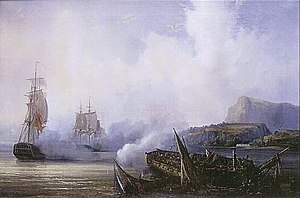| East Indies theatre of the French Revolutionary Wars | |||||||
|---|---|---|---|---|---|---|---|
| Part of the French Revolutionary Wars | |||||||
 Combat de la Preneuse, Auguste Mayer | |||||||
| |||||||
| Belligerents | |||||||
|
|
| ||||||
| Commanders and leaders | |||||||
|
|
| ||||||
The East Indies theatre of the French Revolutionary Wars was a series of campaigns related to the major European conflict known as the French Revolutionary Wars, fought between 1793 and 1801 between the new French Republic and its allies and a shifting alliance of rival powers. Although the Indian Ocean was separated by vast distance from the principal theatre of the conflict in Western Europe, it played a significant role due to the economic importance of the region to Great Britain, France's most constant opponent, of its colonies in India and the Far Eastern trade.
Protection of British interests in the region fell primarily to the Royal Navy, supported by the military forces of the East India Company. Naval strategy sought to eliminate enemy forces in the region and provide convoy protection to the large East Indiamen merchant ships and smaller company ships which transported goods and wealth between Britain and its Asian colonies and trade partners. The French Navy maintained commerce raiding operations in the region throughout the war; particularly light frigate squadrons and privateers deployed in an effort to disrupt British trade, supported as the conflict developed by the allies the French accrued in the course of the war, particularly the Batavian Republic and Spain.
At the declaration of war on Britain by the newly formed French Republic on 1 February 1793, British forces in the Indian Ocean held a considerably stronger military position, which was immediately utilised to seize the French territories in India. The remaining French forces continued operating from their base on the remote island of Île de France, privateers in particular conducting a highly disruptive campaign against British commerce. Attempts by the Royal Navy, commanded by Rear-Admiral Peter Rainier, to limit their effectiveness resulted in a number of inconsequential clashes and a partial blockade of the French islands. In 1795 the declaration of war on Britain by the newly formed Batavian Republic led to successful invasions of the Batavian colonies of Dutch Ceylon, the Dutch Cape Colony and operations against the Dutch East Indies.
In 1796 British control of the region was challenged by a large and powerful French frigate squadron sent to the Indian Ocean under Contre-amiral Pierre César Charles de Sercey. Sercey's squadron operated against British trade for two years with little success; attempts to raid the China trade and coordinate with a Spanish Navy squadron at Manila in the Philippines all ending in failure. Growing resentment on Île de France at the cost of maintaining the squadron eventually required most of the ships to return to France. The survivors, forced to operate independently, were subsequently defeated and captured by the Royal Navy in a series of individual engagements in 1799. By 1800 British control of the Indian Ocean was again assured, Rainier deploying his ships in trade protection duties and in the Red Sea to support the invasion of Egypt in 1801. At the end of the war in 1802 the Peace of Amiens reverted the situation in the region to its pre-war state, Britain returning all seized colonies except for Ceylon.
© MMXXIII Rich X Search. We shall prevail. All rights reserved. Rich X Search
